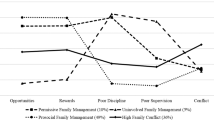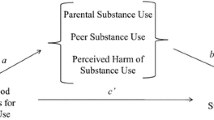Abstract
We tested the relationships and predictive power of family factors on rural, suburban, and urban adolescent substance use. A representative statewide survey of 11th grade students for gender, place of residence, and ethnicity was conducted. No significant differences were found between rural, suburban, and urban adolescents for substance use. For family sanction variables across all locations, adolescent substance involvement was significantly lower the more they perceived their families would “stop them” or “care” if they got drunk, smoked cigarettes, or used marijuana. Rural and suburban youth who reported that their parents talked to them about the dangers of smoking and getting drunk were less involved in substance use. While controlling for location, gender, and ethnicity, regression analyses showed that family sanctions against smoking cigarettes and marijuana explained a modest proportion of the variance in substance use. Finally, “family talking about the dangers of cigarettes,” “family involvement in schools” and “belief that their families cared about them” predicted lower substance use regardless of location, although minimal variance was explained. The findings have implications for social service providers regarding location settings, prevention, education, and intervention programming.
Similar content being viewed by others
REFERENCES
Bachman, J. G., Wallace, J. M., Jr., O'Malley, P. M., Johnston, L. D., Kurth, C. L., Neighbors, H. W. (1991). Racial/ethnic differences in smoking, drinking, and illicit drug use among American high school seniors, 1976–89. American Journal of Public Health, 81, 372–377.
Barnes, G. M., & Welte, J. W. (1986). Patterns and predictors of alcohol use among 7th-12th grade students in New York State. Journal of Studies on Alcohol, 47, 53–62.
Brook, J.S., Brook, D.W., Gordon, A.S., Whiteman, M., & Cohen, P. (1990). The psychosocial etiology of adolescent drug use: A family interactional approach. Genetic, Social, and General Psychology Monographs, 116.
Bursik, R. J., Jr. (1986). Ecological stability and the dynamics of delinquency. In A. J. Reiss and M. Tonry (Eds.), Communities and crime (pp. 79–103). Chicago: University of Chicago Press.
Coombs, R. H., & Coombs, K. (1988). Developmental stages of drug use: Changing family involvements. Journal of Chemical Dependency Treatment, 1, 73–98.
Dembo, R., Williams, L., Wothke, W., & Schmeidler, J. (1994). The relationships among family problems, friends' troubled behavior, and high risk youths' alcohol/other drug use and delinquent behavior: A longitudinal study. The International Journal of Addictions, 29, 1419–1442.
Donnermeyer, J. F. (1992). The use of alcohol, marijuana, and hard drugs by rural adolescents: A review of the recent research. Drugs and Society, 7, 31–75.
Edwards, R. W. (1992). Drug and alcohol use by youth in rural America: An introduction. In R. W. Edwards (Ed.), Drug use in rural American communities (pp. 1–8). New York: The Haworth Press, Inc.
Edwards, R. W. (1994). Alcohol, tobacco, and other drug use by youth in rural communities. In J. Blaser (Ed.), Perspectives on violence and substance use in rural America (pp. 65–86). Chicago: The Midwest Regional Center for Drug-Free Schools and Communities and the North Central Regional Educational Laboratory.
Erikson, E. H. (1968). Identity: Youth and crisis. New York: Norton.
Farrell, A. D., Anchors, D. M., Danish, S. J., & Howard, C. W. (1992). Risk factors for drug use in rural adolescents. Journal of Drug Education, 22, 313–328.
Freudenberg, W. R., & Jones, R. E. (1986). The density of acquaintanceship: An overlooked variable in community research. American Journal of Sociology, 92, 27–63.
Grotevant, H. D. (1983). The contribution of the family to the facilitation of identity formation during early adolescence. Journal of Adolescence, 3, 225–237.
Grunbaum, J. A., Basen-Engquist, K., & Pandey, D. (1998). Association between violent behaviors and substance use among Mexican-American and non-Hispanic White high school students. Journal of Adolescent Health, 23, 153–159.
Hawkins, J.D., Catalano, R.F., & Miller, J. Y. (1992). Risk and protective factors for alcohol and other drug problems in adolescence and early adulthood: Implications for substance abuse prevention. Psychological Bulletin, 112, 64–105.
Holmbeck, G. N., & Hill, J. P. (1988). Storm and stress beliefs about adolescence: Prevalence, self-reported antecedents, and effects of an undergraduate course. Journal of Youth and Adolescence, 17, 285–306.
Hundleby, J., & Mercer, G. (1987). Family and friends as social environment and their relationship to young adolescents' use of alcohol, tobacco, and marijuana. Journal of Clinical Psychology, 44, 125–134.
Johnston, L. D., O'Malley, R. M., & Bachman, J. G. (1992). Smoking, drinking, and illicit drug use among American secondary school students, college students, and young adults. 1975–1991. (NIH Publication No. 93–3481). Rockville, MD: National Institute on Drug Abuse.
Kaufman, E., & Kaufman, P. (1979). Family therapy of alcohol abuse. New York: Gardner Press.
Kowalski, G. S., & Duffield, D. (1990). The impact of the rural population component on homicide rates in the United States: A county-level analysis. Rural Sociology, 55, 76–90.
Norem-Hebeisen, A., Johnson, D. W., Anderson, D., & Johnson, R. (1984). Predictors and concomitants of changes in drug use patterns among teenagers. Journal of Social Psychology, 124, 43–50.
Oetting, E. R., & Beauvais, F. (1987). Peer cluster theory, socialization characteristics, and adolescent drug use: A path analysis. Journal of Counseling Psychology, 34, 205–213.
Oetting, E. R., & Beauvais, F. (1990). Orthogonal cultural identification theory: The cultural identification of minority adolescents. The International Journal of Addictions, 25, 655–685.
Sampson, R. J. (1985). Neighborhood and crime: The structural determinants of personal victimization. Journal of Research in Crime and Delinquency, 22, 7–40.
Sampson, R. J., Raudenbush, S. W., Earls, F. (1997). Neighborhoods and violent crime: A multilevel study of collective efficacy. Science, 277, 918–924.
Scheer, S. D., & Unger, D. G. (1998). Russian adolescents in the era of emergent democracy: The relationships among family environment, drug use, and depression. Family Relations, 47, 297–303.
Scheer, S. D., Unger, D. G., & Brown, M. H. (1996). Adolescents becoming adults: Attributes for adulthood. Adolescence, 31, 127–132.
Spoth, R., Yoo, S., Kahn, J. H., & Redmond, C. (1996). A model of the effects of protective parent and peer factors on young adolescent alcohol refusal skills. The Journal of Primary Prevention, 16, 373–394.
Swaim, R. C., Bates, S. C., & Chavez, E. L. (1998). Structural equation socialization model of substance use among Mexican-American and White non-Hispanic school dropouts. Journal of Adolescent Health, 23, 128–138.
Wills, T. A., Vaccaro, D., & McNamara, G. (1992). The role of life events, family support, and competence in adolescent substance use: A test of vulnerability and protective factors. American Journal of Community Psychology, 20, 349–374.
Author information
Authors and Affiliations
Rights and permissions
About this article
Cite this article
Scheer, S.D., Borden, L.M. & Donnermeyer, J.F. The Relationship Between Family Factors and Adolescent Substance Use in Rural, Suburban, and Urban Settings. Journal of Child and Family Studies 9, 105–115 (2000). https://doi.org/10.1023/A:1009467817313
Issue Date:
DOI: https://doi.org/10.1023/A:1009467817313




